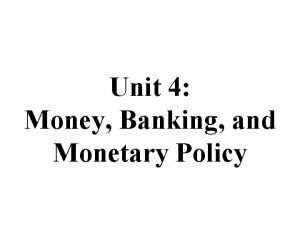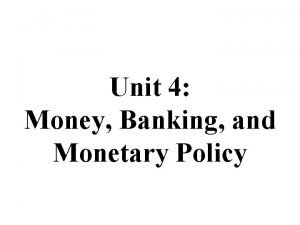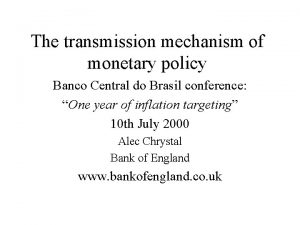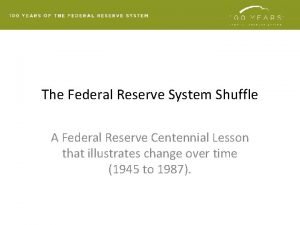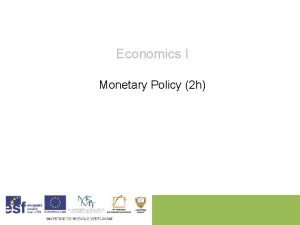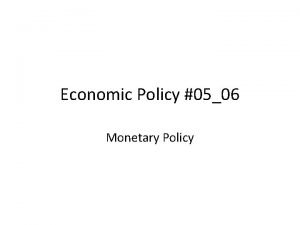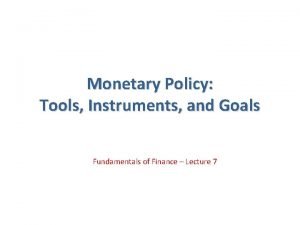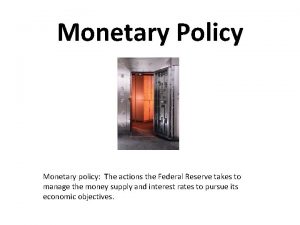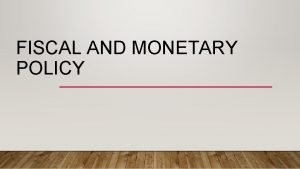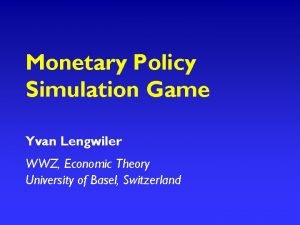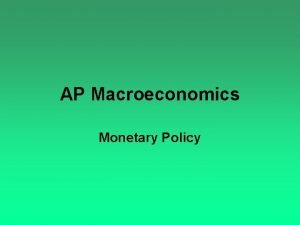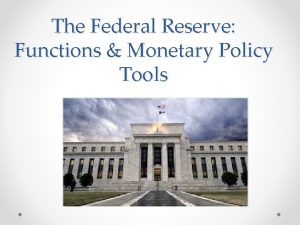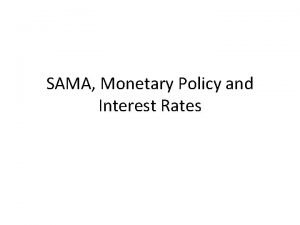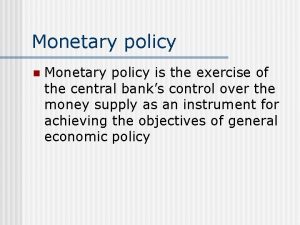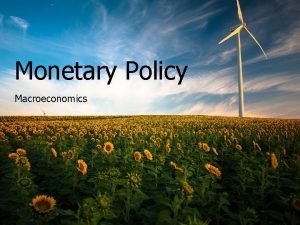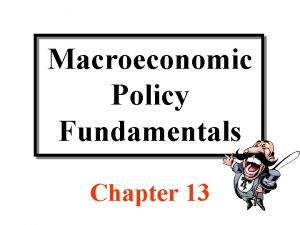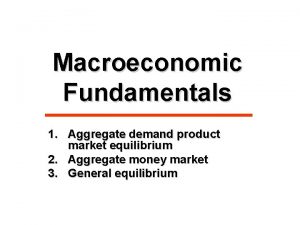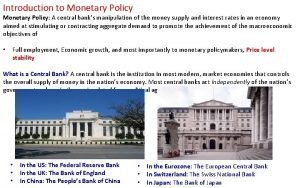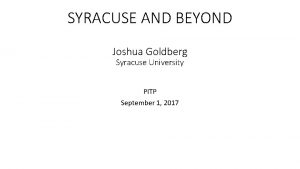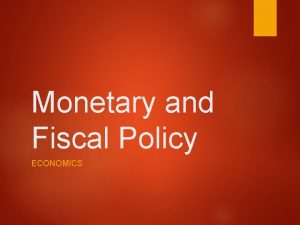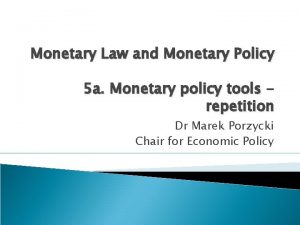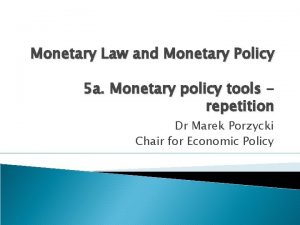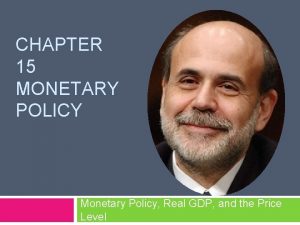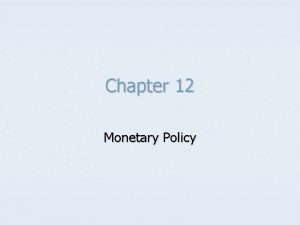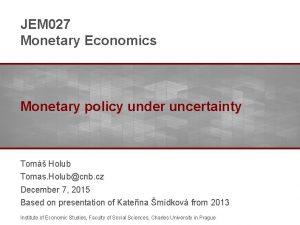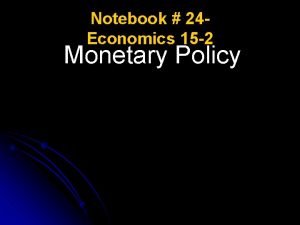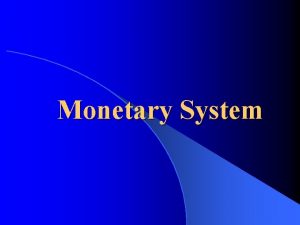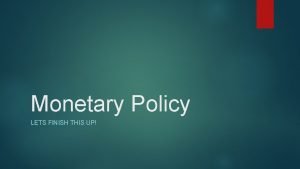Monetary Policy Syracuse Economics Chapter 16 Monetary policy

























- Slides: 25

Monetary Policy Syracuse Economics Chapter 16

• Monetary policy – manipulation the supply of liquidity or financial capital • Many countries have a central bank which does this • European Central Bank does this for all countries that use the Euro

In the US • The monetary authority is called the Federal Reserve, or Fed • It was established by Congress in 1913 • Operates independently from direct political control • Chair – appointed by President, approved by Senate to a 4 -year renewable term

• • • 7 members - presidential appointees, 14 -year non-renewable terms Previous Chairman – Alan Greenspan Current chairman – Ben Bernanke http: //www. clevelandfed. org/About_Us/wh o_we_are/about_the_system/index. cfm

Fed Divided into 12 Districts

The Federal Open Market Committee (FOMC) • The FOMC is made up of the 7 Fed Board members, plus 5 of the presidents of the district banks • The FOMC is really the group that decides the nation’s monetary policy • http: //www. federalreserve. gov/newsevents /press/monetary/20100428 a. htm

• The Fed and the Treasury Department are not the same • Fed is independent agency • Treasury – Department in Executive branch which collects taxes and pays government’s bills

Open Market Operations • The selling and buying of US Treasury Bonds by the Fed in the open market (That is, to or from banks). It is the primary monetary policy tool the Fed has at its disposal.

• The treasury borrows money by selling treasury bonds or bills • They are an IOU – pay you back with interest in the future • Sold to individuals and institutions in the open market

• Bond costs $10, 000 • Pays $1, 000 interest a year for 30 years (10% interest) • Returns the $10, 000 to you after the 30 years are up

The financial capital market • Functions through the buying and selling of these bonds • Governments and businesses sell bonds to borrow money • When you sell a bond, you are demanding financial capital, offering an IOU to get some liquidity • When you buy a bond, you are supplying financial capital, giving up your liquidity for an IOU

If you hear in the news about the bond market • that’s another way of reporting activity in the financial capital market • Bond prices and interest rates move in opposite directions • As 30 -year bond prices rise, 30 -year interest rates fall

• A financial system - arrangement of institutions that coordinate intentions of supplier or demanders of financial capital • Banks are a financial intermediary – a gobetween for suppliers and demanders of financial capital • Others like savings and loans and credit unions also serve this function • Banks pay a rate of interest to savers, and Charge a higher rate of interest to borrowers

• Banks hold assets and have liabilities • Asset – anything that has value in the market • Liability – claim by others on your assets • Your portfolio – all the assets and liabilities you have • A portfolio can be represented by a taccount

Liquidity • the speed with which an asset can be exchanged without sacrificing value • Cash - most liquid • Insurance policy - less liquid • House - very illiquid

Reserves • are very liquid assets held by banks to cover any claims against the bank’s assets that may occur • If a bank held all its assets in cash, • we would say it was operating on a full reserve system

• It is virtually never necessary for • A bank to hold full reserves • Banks become very adept at predicting what their cash needs will be • Banks hold just a little bit beyond what they need, and these are called excess reserves • Banks don’t want too many excess reserves, because they can use depositor’s money to make money

• Fractional reserve systems are very good for an economy • Financial capital can be constantly active • As you save, someone else can use your capital and put it to work • As long as banks don’t distort the market (ex. through discrimination in loaning), they provide a valuable service to the community

Downside of Fractional Reserve System • Banks are always pushing the limit, • wanting to loan out as much as possible to make more money • If people feel a bank is in trouble, they might panic, and cause a run on the bank

After the Great Depression • the Federal Deposit Insurance Corporation (FDIC) was established • Insured individual deposits up to a certain amount • Today - $100, 000 • Intended to reduce likelihoods of a run

The Fed & Open Market Operations • Primary policy tool the Fed has – • Open market operations • This means buying and selling U. S. bonds to and from banks in the open market

When the Fed buys Bonds • It replaces an illiquid asset for the bank (the bond) with a very liquid asset (financial capital) • Banks now have excess reserves • The quickest way to get rid of these excess reserves is by making overnight loans to other banks which need liquidity to meet the reserve requirement

This market among banks for overnight borrowing • is called the Federal Funds Market • The interest rate paid on these overnight loans is called the Federal Funds Rate • Fed buys bonds, expands the supply of capital, so the Federal Funds Rate drops

When the Fed sells bonds • It replaces an liquid asset for the bank (financial capital) with a very illiquid asset (the bond) • Fewer reserves, supply of reserves contracts • Federal funds rate rises

• Another tool the Fed can use is the Discount Rate • Any bank can go directly to the Fed for loans • The Discount Rate is the rate the Fed charges banks • Lower Discount Rate, more borrowing, more liquidity in circulation • Higher Discount Rate, less borrowing, less liquidity in circulation
 Unit 4 money banking and monetary policy
Unit 4 money banking and monetary policy Unit 4 money banking and monetary policy
Unit 4 money banking and monetary policy Transmission mechanism
Transmission mechanism Lesson quiz 16-1 monetary policy
Lesson quiz 16-1 monetary policy What are the objectives of monetary policy
What are the objectives of monetary policy What is the meaning of monetary policy
What is the meaning of monetary policy Monetary policy types
Monetary policy types Expansionary monetary policy effects
Expansionary monetary policy effects What are the objectives of monetary policy
What are the objectives of monetary policy Objectives of monetary policy
Objectives of monetary policy Expansionary monetary policy
Expansionary monetary policy Three tools of monetary policy
Three tools of monetary policy Monetary policy summary
Monetary policy summary Fiscal vs monetary policy
Fiscal vs monetary policy Monetary policy simulation game
Monetary policy simulation game Monetary policy types
Monetary policy types Instruments of monetary policy
Instruments of monetary policy Fiscal policy to control inflation
Fiscal policy to control inflation Moral suasion bsp
Moral suasion bsp Ano ang tight money policy
Ano ang tight money policy Tools of monetary policy ppt
Tools of monetary policy ppt Instruments of monetary policy
Instruments of monetary policy Expansionary monetary policy flow chart
Expansionary monetary policy flow chart Monetary policy
Monetary policy Expansionary money policy
Expansionary money policy Contractionary money policy
Contractionary money policy
